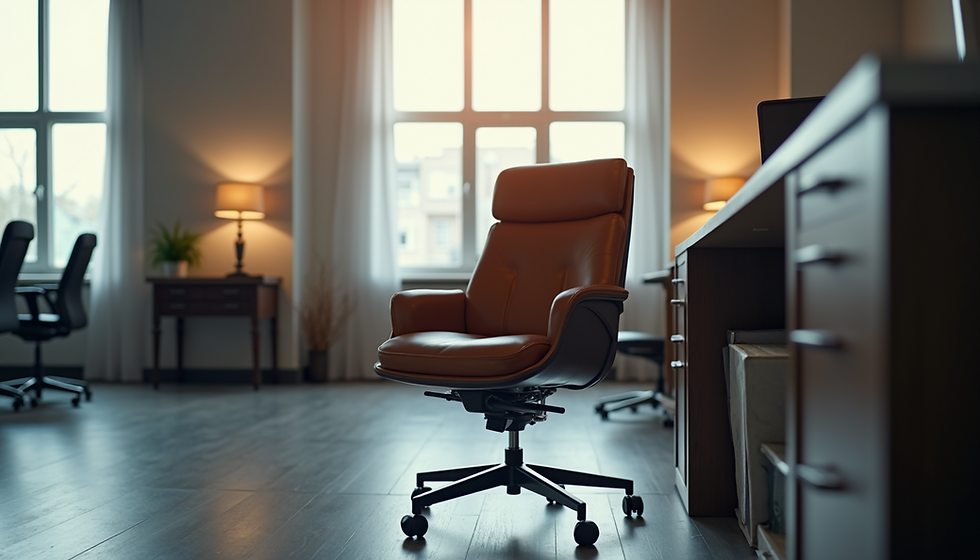Key Features to Look for in a Director's Desk
- janet650
- Jun 17
- 4 min read
Selecting a director's desk is more than just choosing a piece of furniture. It's about finding a workspace that reflects professionalism, facilitates productivity, and enhances the overall aesthetic of your office. For directors and executives, a well-designed desk can symbolize authority and serve as a hub for decision-making. In this blog post, we will explore key features that you should consider when choosing a director's desk to ensure it meets all your professional needs.
Understanding the Director's Desk
The director's desk is typically larger than standard office desks, allowing ample space for papers, reports, and technology. Designed to create an impression, it often features elegant materials, finishes, and designs. Understanding what makes a director's desk stand out requires looking at various essential features.
Size and Space Considerations
One of the most critical factors in selecting a director’s desk is size. The ideal desk should comfortably accommodate all necessary items without appearing cramped. A common size for executive desks is in the range of 60 to 72 inches in width. This space allows not only for a computer but also additional items like paperwork, telephones, and personal effects.
Additionally, consider the layout of your office. A larger desk may be impressive but might overwhelm a small space. Conversely, a smaller desk in a vast office may get lost. Finding a balance where the desk complements the overall office design is key.

Material Quality and Aesthetic Appeal
The materials used in a director's desk can greatly affect its durability and visual appeal. Common materials include hardwood, metal, glass, and laminates.
Hardwood: A classic choice, hardwood desks exude sophistication and can last for decades. They are sturdy and often come with intricate details, adding a touch of elegance.
Glass: Offering a modern flair, glass desks can make a small space feel larger. However, they can be prone to scratches and require more maintenance.
Laminates: These desks may not have the long-term durability of hardwood but can offer a broad range of styles at a lower price point.
When choosing materials, consider both aesthetics and practicality. Look for finishes that resist wear and tear while aligning with the overall design of your office.

Ergonomics and Comfort
Directors often spend long hours at their desks, making comfort an essential feature. An ergonomic desk should allow for proper posture and movement.
Adjustable Height: A desk with an adjustable height can accommodate standing or sitting positions, promoting better health and comfort.
Design: Look for features like rounded edges and adequate spacing to ensure comfortable movement throughout the workspace.
Additionally, consider integrating ergonomic chairs that complement the desk. An optimal working environment will enhance productivity while promoting better health.
Versatility and Storage Solutions
A well-designed director's desk should offer versatility and functional storage solutions. Look for desks that include built-in shelving or drawers for storing essential documents and office supplies.
Hidden Storage: Concealed storage options help maintain a clean and organized look. This can include drawers that blend seamlessly into the design of the desk.
Modular Designs: If flexibility is important, consider modular desks that allow you to adapt the workspace according to changing needs.
These features ensure that the desk not only serves as a workspace but also as an efficient organizational tool.

Technology Integration
In today's digital world, technology integration becomes a crucial feature to consider. Your director's desk should accommodate various technological needs such as computers, printers, and other office equipment.
Cable Management: Look for desks that include cable management solutions to keep cords organized and out of sight.
Device Integration: Some desks come with built-in power outlets or USB ports, providing easy access for charging devices without clutter.
Ensuring that your desk can accommodate current and future technology will keep your workspace efficient and streamlined.
Personalization and Professionalism
Lastly, a director's desk should reflect your personal style while projecting professionalism.
Customization: Some manufacturers offer customizable options for desks, allowing you to choose the size, configuration, and finishes that best suit your taste.
Accessories: Consider incorporating accessories like a stylish desk lamp, a high-quality mouse pad, or elegant stationery that adds character without compromising on professionalism.
Your desk should be a reflection of you—efficient, organized, and beautiful.

Final Thoughts on Choosing the Right Director's Desk
Choosing the right director's desk is not a task to be taken lightly. By considering size, material, ergonomics, storage solutions, technology integration, and personalization, you can select a desk that meets your professional needs while creating a conducive work environment. If you find yourself in Singapore, explore options like the director table singapore to find the perfect blend of style and functionality.
When investing in office furniture, remember that your workspace is an extension of your personal brand and work ethic. A well-chosen desk can inspire confidence and serve as a foundation for success.






Comments